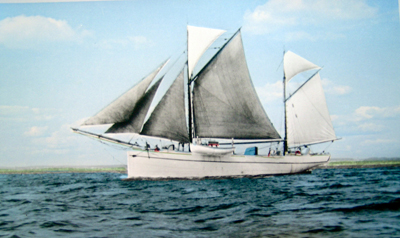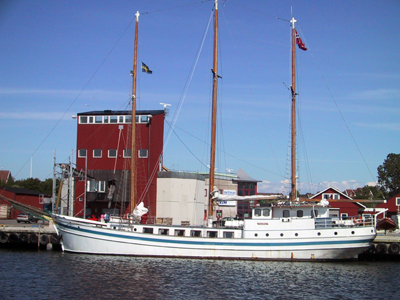Elida I
Elida I was a german-built English cutter, built in 1876. She came to Sweden and Gullholmen in 1907 under the name Elida, and the first Swedish owner was A. L. Abrahamsson. When she was bought by the newly-founded Elida organization in 1963, Anders Lennart Verner Abrahamsson (also called “Tarren”) was issued as the buyer.
During the winter of 1963-64, she was prepared and somewhat remodeled, and on 1 May 1964, she was inaugurated. She sailed until 1966, when a shore at the dry dock went straight through the planking.
Elida I now rests at the ship graveyard outside Donsö Svartskär, in the Gothenburg archipelago.
Facts in brief
Rigging type: ketch
Length: 26 m (waterline/lpp: 23.5 m)
Breadth: 5.6 m
Depth: 3 m
Displacement: 78 T
Sail area: 220 m2
Mast height: 20 m
Engine: Volvo Penta D96
Speed: 6 knots
No. of bunks: 26

Elida II
Elida II was a beautiful ship, built in Svendborg, Denmark, in 1896, and made her virgin sail under the name Nåden (The Grace). She ended up in Sweden a few years later and was named Rita. The skipper family was Akervall, and the ship received her berth place in Hamburgsund.
A noteworthy detail is that this proud little sailing vessel brought Jewish families into freedom during World War II.
In 1949 she was a worn-down old lady, but with her slender lines, Akervall still chose to reconstruct her. The Sjötorp Shipyard took her down, all the way down to keel and then rebuilt her into a close-to new ship. The flat stern was replaced by a twisted stern, and she soon recevied the nickname ”the swan of Bohuslän.”
In 1966 she became Elida II and then sailed as the Swedish Elida until 1981, when she became the Norwegian Elida, bought by our sister organization. She sailed a total of 30 years as Elida. Unfortunately, the shipworm eventually took over, and with its certificate withdrawn, she functioned as a café in the port of Oslo for some years, until she was cut up in 2019 when it was deemed too expensive to do the necessary repair that the insurance company required.
Facts in brief
Rigging type: ketch
Length: 24.75 m (waterline/lpp: 22 m)
Breadth: 5.4 m
Depth: 2.9 m
Displacement: 107 T
Sail area: 180 m2
Mast height: 20 m
Engine: Volvo Penta, 196 kW
Speed: 8 knots
No. of bunks: 48

Elida III
Elida III was built in Karlstad, Sweden, as one of the nation’s last sailing cargoship. This was in a time when some were still riveting ships, and welding had just begun. Finn, as she was called at the beginning, was welded sheet irons but riveted frames, and she was built to transport grain. The skipper was called Osvald and came from Bleket on the Swedish island Tjörn.
After the some owner changes, she ended up in Trondheim, where Tarren bought her together with some friends. She was remodeled completely at the fine old shipyard Trellevarvet on the island Kållandsö by Harry Jonsson, a legendary profile within the sailing ship and shipyard epoch.
Many people volunteered at the shipyard making her ready for sail, and on 1 May 1982, she was inaugurated in Kungshamn.
A few years later, in 1988, she sailed – just like Elida II – over to Norway, where she then sailed as Norwegian Elida until 1995, when she made a tour in Stockholm under the name “Victoria af Stockholm.”
But already in 1998, she was back in Norway as Elida again and sailed until 2002, when her certificate was withdrawn.
The question about her future was at first a great concern, but she was finally sold and rebuilt to serve as a rehabilitation centre for addicts in Denmark.
Facts in brief
Rigging type: 3-masted for-and-aft schooner
Length: 31 m (waterline/lpp: 26 m)
Breadth: 6.4 m
Depth: 3 m
Displacement: 220 T
Sail area: 400 m2
Mast height: 25 m
Engine: Volvo Penta, 260 kW
Speed: 9 knots
No. of bunks: 52

Elida IV
Elida IV was built at GVA in Gothenburg during the winter of 1987-88. It had a sturdy construction with evident traits from Elida II and III but was built according to the new demands on safety and equipment. The ship was designed and constructed by FKAB in Uddevalla, Sweden, in cooperation with the Elida crew, and she was finished in May 1988.
The ship was classified as a trainee vessel for ocean trade, with a passenger certificate for coastal trade. The rigging type was from the beginning something called Bermuda barquentine, or topsail schooner, but was later changed into a ketch with much higher masts.
She was sold in 2007 to Youth With A Mission (YWAM) England, Marine Reach.
Facts in brief
Rigging type: ketch
Length: 32.8 m (waterline/lpp: 27.5 m)
Breadth: 6.8 m
Depth: 3 m
Displacement: 230 T
Sail area: 500 m2
Mast height: 32.8 m
Engine: Cat 3408, 330 kW
Speed: 10 knots
No. of bunks: 52
